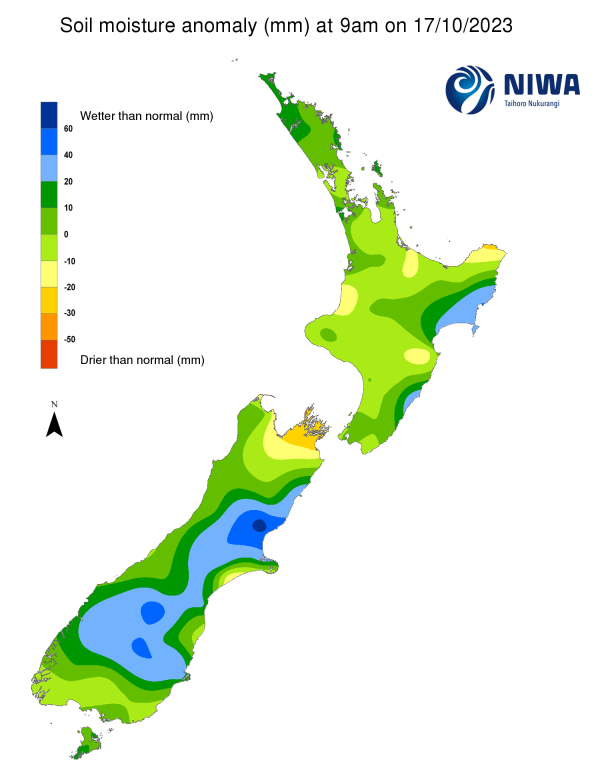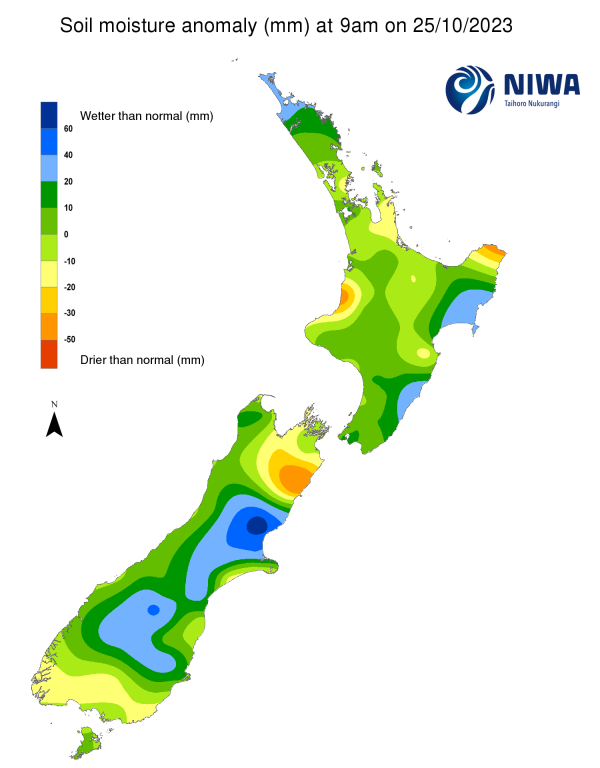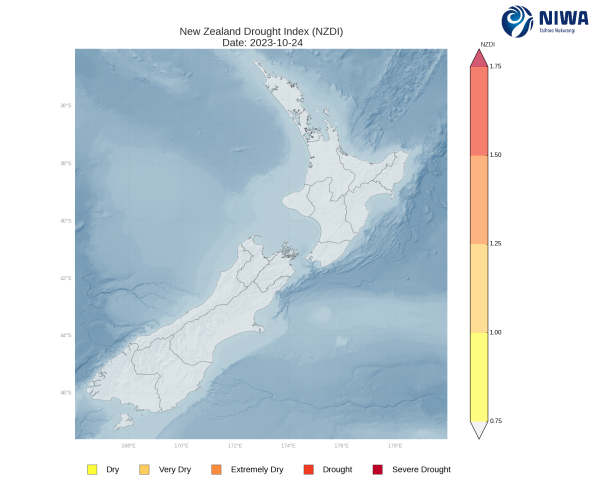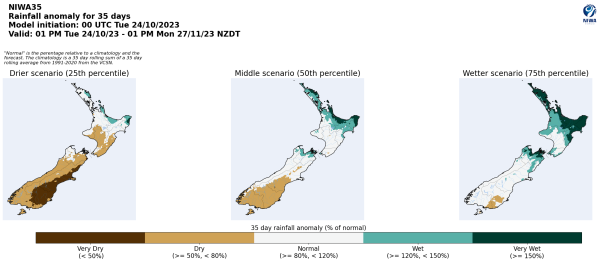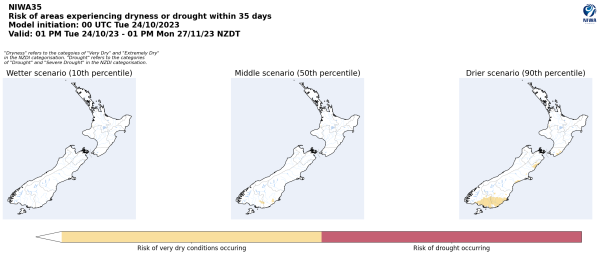A weekly update describing soil moisture patterns across the country to show where dry to extremely dry conditions are occurring or imminent. Regions experiencing significant soil moisture deficits are deemed “hotspots”. Persistent hotspot regions have the potential to develop into drought.
Recent rainfall and current soil moisture conditions:
North Island:
- Rainfall of 30-60 mm was observed in eastern Bay of Plenty and small pockets of northern Waikato in the past week.
- However, a majority of the upper and central North Island saw rainfall totals of 5-25 mm, with 10 mm or less in the lower North Island.
- This resulted in small to moderate soil moisture changes across a majority of the North Island.
- The driest soils across the North Island, when compared to normal for this time of the year, are found near East Cape and southwestern Waikato, while the wettest soils for this time of the year are found in the Far North along with southern Gisborne and parts of Hawke’s Bay.
- No hotspots currently exist in the North Island.
- As of 24 October, the New Zealand Drought Index (NZDI) map below shows that no unusually dry conditions are currently found across the North Island.
South Island:
- Rainfall of 30-70 mm occurred across large portions of the West Coast in the past week, including Tasman.
- However, the remainder of the South Island only saw light rainfall of 10 mm or less.
- This resulted in small to moderate soil moisture decreases across a majority of the South Island, although little change was observed in the West Coast.
- The driest soils across the South Island, when compared to normal for this time of the year, are found in the Kaikōura District, while the wettest soils for this time of the year are found in north-central Canterbury.
- In the past week, a new hotspot has formed along the border of eastern Marlborough and the Kaikōura District.
- As of 24 October, the New Zealand Drought Index (NZDI) map below shows that no unusually dry conditions are currently found across the South Island.
Pictured above: Soil Moisture Anomaly Maps, relative to this time of year. The maps show soil moisture anomalies over the past two weeks.
As of 24 October, the New Zealand Drought Index (NZDI) map below shows that no unusually dry conditions are currently found across the country. Please note: some hotspots in the text above may not correspond with the NZDI map. This difference exists because the NZDI uses additional dryness indices, including one which integrates the rainfall deficit over the past 60 days. Changes are therefore slower to appear in the NZDI compared to soil moisture anomaly maps that are instantaneously updated.
The week ahead:
North Island:
- On Thursday night and Friday (26-27 October) a cold front will move up the North Island, bringing light to moderate rainfall to the western half of the island in particular.
- High pressure will bring dry weather to the North Island during the weekend, although rain may begin to affect Northland by Sunday afternoon (29 October).
- Moisture from the remnants of ex-Tropical Cyclone Lola is likely to affect the North Island on Monday and Tuesday, with parts of the upper and eastern North Island likely seeing heavy rain on Monday.
- By the middle of next week there may be at least a brief drier window.
- Weekly rainfall totals of 50-100 mm will be possible in the upper half of the North Island, with isolated higher amounts. Farther south, weekly totals of 30-50 mm are expected.
- Due to the expected rainfall in the next week, soil moisture levels may increase significantly, especially in the northern half of the island.
- No hotspots are expected to form in the North Island in the next week.
South Island:
- After a few showers on Friday (27 October), high pressure will bring dry weather to the South Island from Saturday to Monday.
- By Tuesday (31 October), the remnant moisture from ex-Tropical Cyclone Lola could result in showers or rain in the upper South Island, but rainfall amounts are not expected to be significant at this time.
- The middle portion of next week may feature scattered showers.
- Weekly rainfall totals of 20-40 mm are expected along the West Coast, with generally less than 20 mm elsewhere. However, parts of Canterbury may see rainfall totals of less than 10 mm.
- Due to the expected rainfall in the next week, soil moisture levels are likely to decrease across most regions, with the largest decreases expected in the eastern South Island.
- The current hotspot located along the border of eastern Marlborough and the Kaikōura District could strengthen and expand at least slightly in the next week, although no additional hotspots are expected to form.
Long-term outlook (through late November):
- The wetter than normal anomalies (green) shown in the maps below are mostly the result of the remnant moisture from ex-Tropical Cyclone Lola that is expected to affect the upper and eastern North Island in the coming days.
- The drier (25th percentile) and middle (50th percentile) scenarios both favour drier than normal conditions in the South Island, with very dry conditions potentially signalled in Canterbury and Otago.
- However, in the wetter (75th percentile) scenario, near normal rainfall is favoured for many of these areas.
- Particularly in the drier rainfall scenario, there is a signal for dry conditions to emerge in parts of the eastern and lower South Island over the next 35 days.
Pictured above: 35-day forecast rainfall anomaly scenarios (Top), and 35-day forecast dryness and drought scenarios (Bottom). These maps are updated daily at https://niwa.co.nz/climate/seasonal-climate-outlook
Background:
Hotspot Watch: a weekly advisory service for New Zealand media. It provides soil moisture and precipitation measurements around the country to help assess whether extremely dry conditions are imminent.
Soil moisture deficit: the amount of water needed to bring the soil moisture content back to field capacity, which is the maximum amount of water the soil can hold.
Soil moisture anomaly: the difference between the historical normal soil moisture deficit (or surplus) for a given time of year and actual soil moisture deficits.
Definitions: “Extremely” and “severely” dry soils are based on a combination of the current soil moisture status and the difference from normal soil moisture (see soil moisture maps at https://www.niwa.co.nz/climate/nz-drought-monitor/droughtindicatormaps)
Hotspot: A hotspot is declared if soils are "severely drier than normal" which occurs when Soil Moisture Deficit (SMD) is less than -110 mm AND the Soil Moisture Anomaly is less than -20 mm.

